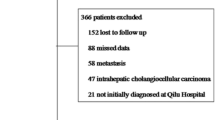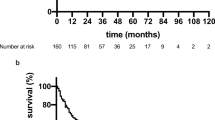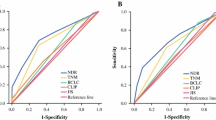Abstract
Objective: To analyze correlation between TNM classification of hepatocellular carcinoma (HCC) and disease-free survival in order to evaluate its significance in predicting the long-term result after hepatctomy. Methods: A retrospective survey was carried out in 1,725 cases with HCC patients performed hepatectomy from January 1990 to December 1995. The follow-up rate was 84.5%. The prognostic factors were analyzed by Cox proportional hazards survival model and disease-free survival was calculated by Kaplan-Meier estimation. Results: Univariate analysis showed thirteen clinicopathological prognostic factors including TNM staging. Multivariate analysis revealed four significant predictors such as preoperative lesion number, tumor size, daughter nodules and vascular invasion, which were encompassed in TNM classification. The 5-year disease-free survival rate were 24.6% of stage I, 38.4% of stage II, 15.9% of stage III, and 5.3% of stage IVa respectively. There was no significant difference in disease-free survival between stages I and II. Conclusion: TNM staging is one of the most significant prognostic factors in predicting disease-free survival of HCC patient after hepatectomy, but some items need modifying.
Similar content being viewed by others
References
Wu MC, Zhang BH. Present state and advances of hepatic surgery in China. Chin J Surg 1996; 34: 515.
Cox DR. Regression models and life-tables. J R Statist Soc B 1973; 34:187.
Wu MC, Ma ZC, Yang BH, et al. Criteria of clinical classification and the definition of small liver cancer. In: Tang ZY, ed. Primary liver cancer. Standards of diagnosis and treatment of Chinese common malignant tumor. 1st. Bei**g: Bei**g Medical University and **ehe Medical University of the Chinese Academy of Medical Sciences Press 1990; 12–13.
UICC. TNM classification of malignant tumors. 4th ed. Berlin: springer-Verlag, 1987; 53–57.
Nagahisa F, Katsuji S, Hirooaki K, et al. Result of treatment of patients with hepatocellular carcinoma with severe cirrhosis to the liver. World J Surg 1989; 13:211.
Izumi R, shimizu K, Ii T, et al. Prognostic factors of hepatocellular carcinoma in patients undergoing hepatic resection. Gastroenterology 1994; 106: 720.
Wittekind C. Prognostic factors in liver tumors. Verh Dtsch Ges pathol 1995; 79: 109.
Yamasaki S. TNM classification of liver cancer. Gan to Kagaku Ryoho 1997; 24: 1175.
Yang BH. Study of clinical type and classification of primary liver cancer. In: Tang ZY, Yang BH, ed. Advances in primary liver cancer research. Shanghai: Shanghai Medical University Press 1990: 124–135.
Konstantinov BA, Got’e SV. Surgical classification of liver local lesions. Khirurgiia Mosk 1997; 2: 18.
Author information
Authors and Affiliations
Corresponding author
Rights and permissions
About this article
Cite this article
Zhang, Zj., Wu, Mc., Chen, H. et al. Significance of TNM classification in prognostic evaluation of hepatocellular carcinoma following hepatectomy. Chin J Cancer Res 12, 132–134 (2000). https://doi.org/10.1007/BF02983439
Received:
Accepted:
Issue Date:
DOI: https://doi.org/10.1007/BF02983439




